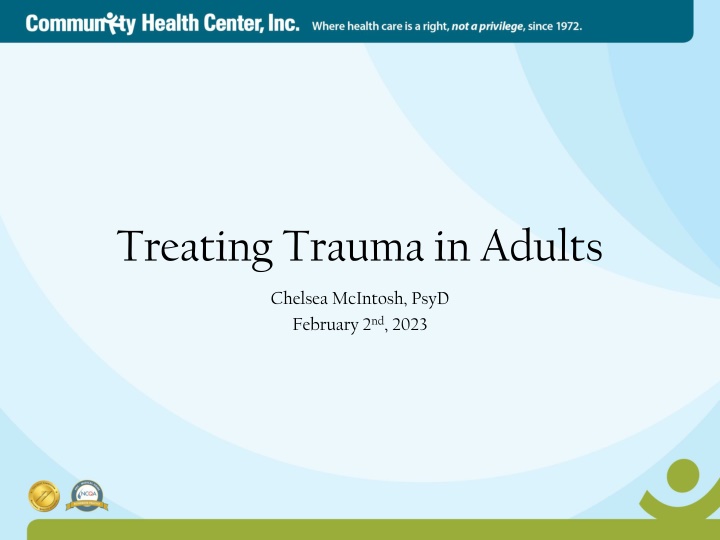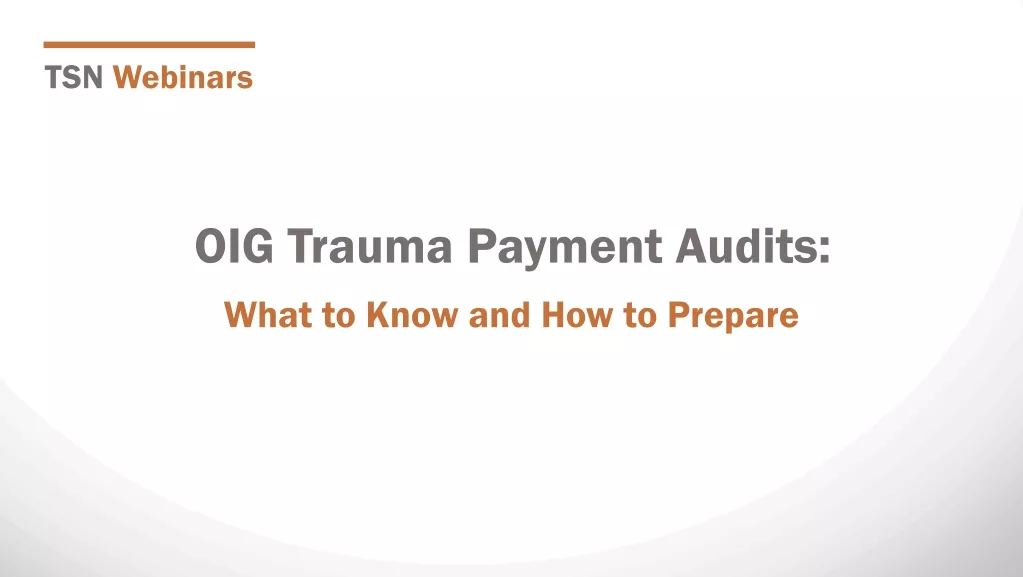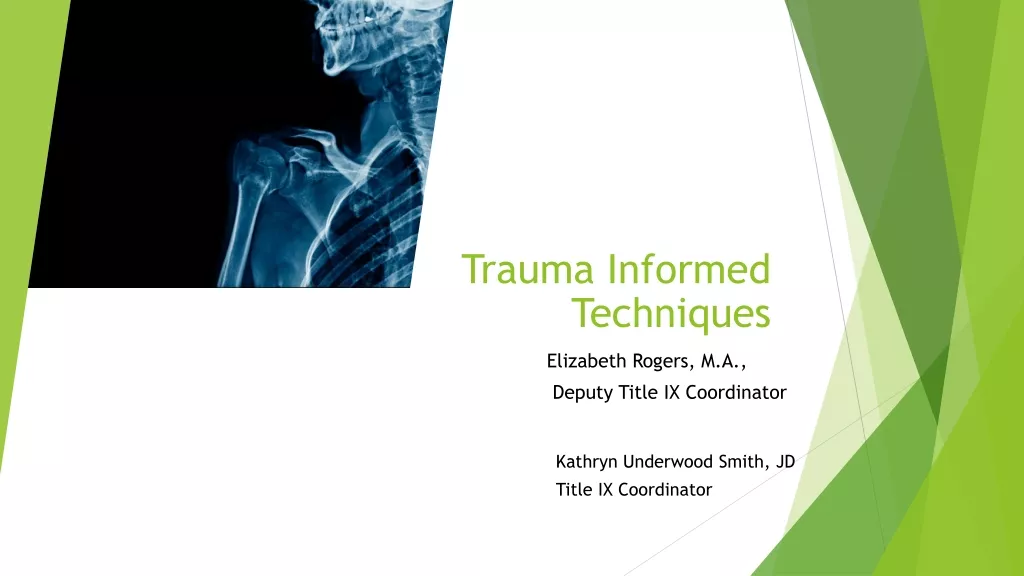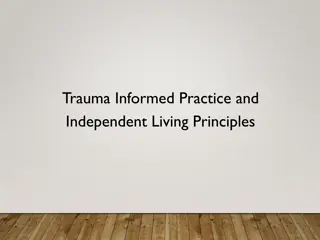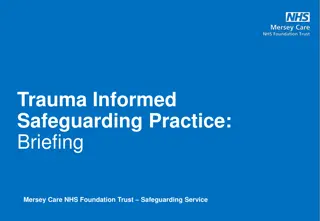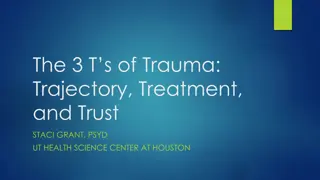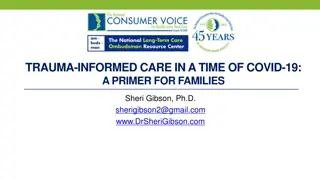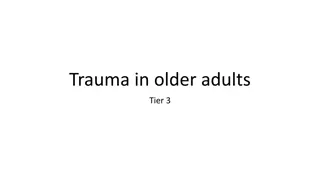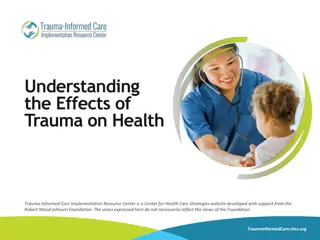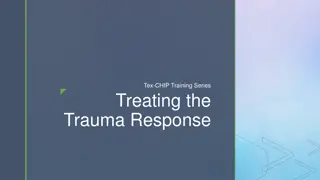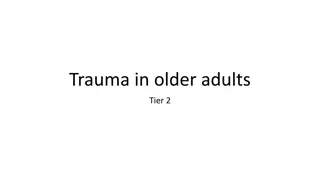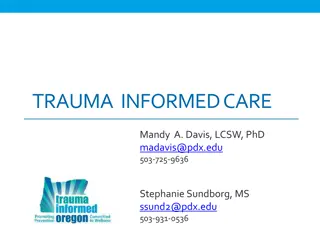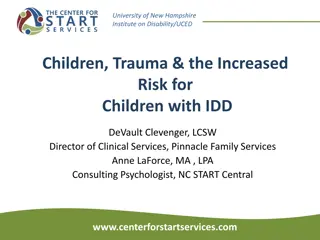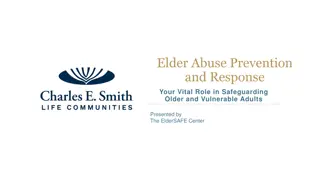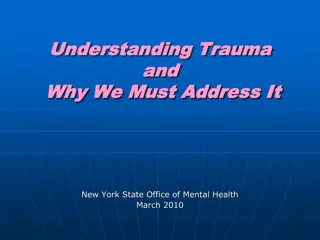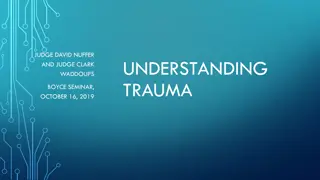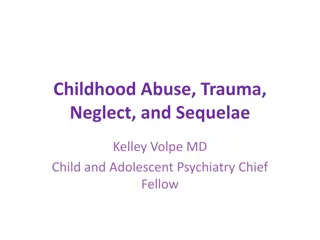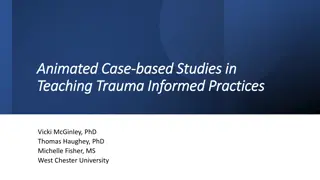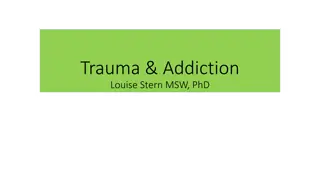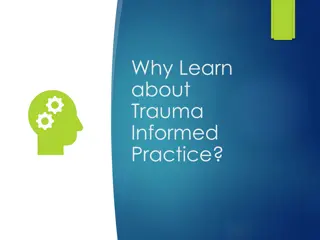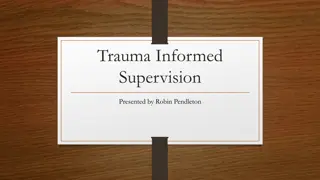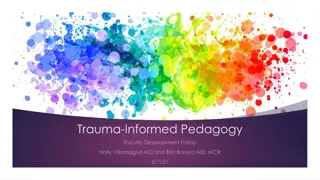Recognizing and Treating Trauma in Adults: A Comprehensive Approach
This presentation focuses on assessing, distinguishing, and treating trauma in adults, emphasizing trauma-informed care principles. It discusses various treatment modalities and the importance of recognizing trauma in clients to provide effective care. The session aims to improve patient outcomes by addressing the underlying trauma that may be contributing to presenting symptoms.
Download Presentation

Please find below an Image/Link to download the presentation.
The content on the website is provided AS IS for your information and personal use only. It may not be sold, licensed, or shared on other websites without obtaining consent from the author.If you encounter any issues during the download, it is possible that the publisher has removed the file from their server.
You are allowed to download the files provided on this website for personal or commercial use, subject to the condition that they are used lawfully. All files are the property of their respective owners.
The content on the website is provided AS IS for your information and personal use only. It may not be sold, licensed, or shared on other websites without obtaining consent from the author.
E N D
Presentation Transcript
Treating Trauma in Adults Chelsea McIntosh, PsyD February 2nd, 2023
Continuing Education Credits In support of improving patient care, Community Health Center, Inc./Weitzman Institute is jointly accredited by the American Psychological Association (APA), Association of Social Work Boards (ASWB), Accreditation Council for Continuing Medical Education (ACCME), the Accreditation Council for Pharmacy Education (ACPE), and the American Nurses Credentialing Center (ANCC), to provide continuing education for the healthcare team. This session is intended for behavioral health clinicians and nurse practitioner residents as part of a behavioral health didactic series. Completing a post-session survey is required to claim your CME/CE credits and certificate. A comprehensive certificate will be available after the conclusion of the series.
Disclosure With respect to the following presentation, there has been no relevant (direct or indirect) financial relationship between the party listed above (or spouse/partner) and any for-profit company in the past 12 months which would be considered a conflict of interest. The views expressed in this presentation are those of the presenter and may not reflect official policy of Community Health Center, Inc. and its Weitzman Institute. I am obligated to disclose any products which are off-label, unlabeled, experimental, and/or under investigation (not FDA approved) and any limitations on the information that I present, such as data that are preliminary or that represent ongoing research, interim analyses, and/or unsupported opinion.
Objectives Discuss how to assess for trauma in adults Identify ways of distinguishing a trauma presentation from other presenting concerns Review considerations to creating a trauma-informed environment in your treatment setting Review general principles of treating trauma in adults
Caveat Reviewing basic principles and interventions of treating trauma in adults Many modalities to treat trauma EMDR, Somatic, Art, Yoga, Performance, Movement Good overview of all modalities found in: Van Der Kolk, B.(2014). The Body Keeps the Score: Brain, Mind, and Body in the Healing of Trauma. Viking.
Recognizing Trauma in Our Clients Trauma is widespread 80 percent of adults in primary care report experiencing one traumatic event (Raja et. al, 2021) Every patient has a story Trauma is at the root of many of the presenting symptoms we see If we are not addressing the root, we may be insufficiently treating the problem
Recognizing Trauma in Our Clients Distinguishing trauma exposure from PTSD Just because someone may not meet criteria for PTSD, does not mean that their exposure to traumatic events is not impacting their symptoms or their way of viewing the world Clients define if an event is traumatic to them Understanding that definition, also understanding when trauma may be normalized
Recognizing Trauma in Our Clients Awareness that some groups are likely to have higher rates of exposure to traumatic events Women Trauma is more likely to occur earlier and last longer, and is more likely to be perpetuated by loved ones (Najavits, 2002) Impact of trauma via non-dominant identities: sociopolitical trauma Considering impact of intersectionality (being in more than one non-dominant group increases risk of exposure to trauma(Classen & Clark, 2017)
A Note on Collective Trauma (Hirschberger, 2018) Traumatic events that affect widespread groups COVID-19 pandemic, climate change, war Impacts overall sense of meaning Shared societal meaning Impact of media exposure (Holman et al., 2019) Correlation of perceived authenticity with recovery from collective trauma (Maffly-Kipp et al., 2020)
Recognizing Trauma in Our Clients (Van Der Kolk, 2014; Barnett et. al., 2020; Ellis, 2020) Developmental trauma (ACEs/Chronic PTSD) can result in presenting: Multiple medical concerns, chronic pain Impact on health related behaviors Correlation with inflammatory processes (Sin et al., 2015) Impact of overactive stress management system impacting immune system and other body systems (Lisak, 2014) Multiple trauma exposures Exposure increases risk of re-traumatization
Recognizing Trauma in Our Clients (Van Der Kolk, 2014; Barnett et. al., 2020; Ellis, 2020) Reduced sense of safety Emotion regulation/interpersonal concerns Difficulty with treatment compliance Increased ACES in marginalized groups, exposure to reduced SDOH quality Intervention priority addressing SDOH Externalization of trauma to sociopolitical structure
Approaching the Criteria A: Exposure to a traumatic event (as defined by DSM 5) What is the event (or events?) Definition of trauma and limits of this criteria (Panisch et al., 2022) Events seen as normative that can be traumatic (eg: living in a high crime area) Shame/hesitancy to respond to the word trauma/traumatic What is some language you could use to assess this criteria not using trauma? Need to assess for presence of more than one event (Adams and Allwood, 2020) Cumulative effect of multiple/repeated events Consider events that result in other criteria s symptoms Traumatic exposure ongoing? Assess for safety
Approaching the Criteria B: Intrusive symptoms (flashbacks, nightmares), dissociation, reactions to certain cues Identify precipitating cues, themes C: Avoidance behaviors (places, people, songs, smells, foods, etc.) Psychoeducation about why these associations are created D: Negative effects on cognitions and mood Discuss beliefs about self, others, world as a result of these event(s) E: Arousal Insomnia Consider B-E symptoms endorsed that there may be an etiology based in trauma exposure even if A is not met
Differential/Comorbid Factors Consider etiology of trauma as a rule out for all diagnoses Common comorbid disorders: Mood disorders Substance use disorders Personality disorders
Trauma Informed Care (Classen & Clark, 2017; Robey et al., 2021) Trauma informed: Realize prevalence, recognize symptoms, respond, resist retraumatization Associated with improved healthcare outcomes Avoid re-traumatizing individuals/promote sense of safety Waiting in waiting room, waiting in room once roomed Sense of control over care Control about when, how and with whom information is shared, right from the intake Collaboration/choice throughout treatment Goals Transparency: Providing explanations Preface anything that you are going to do Open communication
Trauma Informed Care (Classen & Clark, 2017) Structural: consideration of consistent room you use, quiet space Maintaining reliability, predictability Setting clear boundaries/expectations Engage in grounding from the beginning: be aware of nonverbal cues Focus on relationship building Strength based approach Normalize symptoms, provide psychoeducation How are you creating a trauma responsive environment currently? Examples: Levensonet. al, 2023
Psychoeducation of Trauma (Van der Kolk, 2014) Physiological response (fight/flight/freeze) Role of normalizing symptoms in the context of their experiences Body s way of responding to events How traumatic memories are stored and retrieved based on physiological response Stored nonverbally, contributing to flashbacks and cues in association with physiological responses promoting connection to trauma Stored in fragments contributing to confusion and fear when flashbacks/nightmares occur Role of verbalization in re-storing memory Protective behaviors maintaining the symptoms Avoidance, hyper-reactivity
Treatment Need to establish actual safety before working on sense of safety Top down vs bottom up approach: Top down: looks at cognitions Bottom up: focuses on regulation, often a starting point with trauma Coping with physiological response Grounding vs coping skills, role of mindfulness in managing symptoms Goal is not to accept what happened but rather to gain mastery over internal sensations and emotions
Treatment Construct anxiety hierarchy of avoidant cues and participate in exposure If substance use (and other maladaptive coping): identify what the substance/coping served for the client: match the purpose to an appropriate coping skill Past treatment as compared present focused treatment: patients do not need to tell their trauma story in order to recover
Grounding Examples (Najavits, 2002) Mental Grounding Describe your environment in detail using all your senses. Describe objects, sounds, textures, colors, smells, shapes, numbers, and temperature Play a "categories" game with yourself Do an age progression. If you have regressed to a younger age (e.g., 8 years old), you can slowly work your way back up (e.g., "I'm now 9"; 'Tm now 10"; "I'm now 11 "_.) until you are back to your current age Describe an everyday activity in great detail Use an image to address your emotional state Glide along on skates away from your pain; change the TV channel to get to a better show; think of a wall as a buffer between you and your pain Say a safety statement. "My name is __; I am safe right now. I am in the present, not the past. I am located in ___; the date is : ______ Read something, saying each word to yourself. Or read each letter backwards so that you focus on the letters and not on the meaning of words Use humor. Think of something funny to jolt yourself out of your mood. Count 1 to 10 or say the alphabet, very slowly Repeat a favorite saying to yourself over and over
Grounding Examples (Najavits, 2002) Physical Grounding Run cool or warm water over your hands Grab tightly onto your chair as hard as you can Touch various objects around you Notice textures, colors, materials, weight, temperature Compare objects you touch: Is one colder? Lighter? Dig your heels into the floor-- literally "grounding" them Notice the tension centered in your heels as you do this Remind yourself that you are connected to the ground Carry a grounding object in your pocket Jump up and down Notice your body Wiggling your toes in your socks The feel of your back against the chair Stretch. Extend your fingers, arms or legs as far as you can; roll your head around Walk slowly, noticing each footstep, saying "left, right" with each step Eat something, describing the flavors in detail to yourself Focus on your breathing, noticing each inhale and exhale. Repeat a pleasant word to yourself on each inhale (for example, a favorite color or a soothing word such as "safe," or "easy").
Grounding Examples (Najavits, 2002) Soothing Grounding Say kind statements, as if you were talking to a small child Ex: "You are a good person going through a hard time. You'll get through this. Think of favorites. Think of your favorite color, animal, season, food, time of day, TV show Picture people you care about Remember the words to an inspiring song, quotation, or poem that makes you feel better Remember a safe/soothing place (real or imagined) Focus on everything about that place: the sounds, colors, shapes, objects, textures Say a coping statement "1 can handle this", "This feeling will pass. Plan out a safe treat for yourself, such as a piece of candy, a nice dinner, or a warm bath Think of things you are Iookinq forward to in the next week
For Grounding/Coping Skills Role of practice Using when distressed and not distressed Practicing multiple times Finding preferred skills Matching skills to symptoms Having a tool box of multiple skills
Processing Trauma Narrative Full control over trauma narrative, when, where, how, with whom it is processed (no control over trauma) Identify themes related to self/world as a result of that/those experience(s). Work to challenge/reconstruct those beliefs How has this event changed what you think about yourself? and, How has this event changed how you think about others? (Cahill & Foa, 2007) Sit with emotions that arise when processing the narrative and utilize coping/grounding strategies What makes symptoms better? Worse? (positive and negative coping strategies)
Processing Trauma Narrative: Cognitive Appraisals (McIlveen et. al, 2022) Alienation appraisals (disconnection from self and others) associated most strongly with PTSD symptoms Examples: There is a huge void inside me and My friends don t understand my reactions , Association with withdrawal from others, endorsing loneliness Prioritization of building a strong therapeutic alliance
Seeking Safety Cognitive Restructuring Examples (Najavits, 2002) I'm Crazy You believe that you shouldn't feel the way you do Cognitive restructuring: Honor Your Feelings. You are not crazy. Your feelings make sense in light of what you have been through. You can get over them by talking about them and learning to cope. Time Warp It feels like a negative feeling will go on forever Cognitive restructuring: Observe Real Time. Take a clock and time how long it really lasts. Negative feelings will usually subside after a while; often they will go away sooner if you distract with activities. The Past is the Present Because you were a victim in the past, you are a victim in the present Cognitive Restructuring: Notice Your Power. Stay in the present: I am an adult (no longer a child); I have choices (I am not trapped); I am getting help (I am not alone) I am My Trauma Your trauma is your identity; it is more important than anything else Cognitive restructuring: Create a Broad Identity. You are more than what you have suffered. Think of your different roles in life, your varied interests, your goals and hopes.
Consideration of Posttraumatic Growth (Gleeson et al., 2022) Associated with greater appreciation of life, improved interpersonal relationships, greater personal strength, recognition of new possibilities, and spiritual or religious growth Positive appraisals of traumatic event (eg being able to cope with event successfully) associated with posttraumatic growth Potential need to create space for ruminative process related to disrupted schemas associated with event (processing emotional impact of control, safety, identity) prior to transition into PTG process
Consideration of Posttraumatic Growth (Gleeson et al., 2022; Raja et al., 2021) Reduced PTG with interpersonal related events and multiple/prolonged events Consideration of Trauma Appraisal Questionnaire to determine focus of cognitive restructuring betrayal, self-blame, fear, alienation, anger, and shame Betrayal and shame associated with PTG significantly Resilience associated with single events, having a support system, healthy coping strategies
References Adams, S. & Allwood, M. (2020). Profiles of home violence and posttraumatic stress symptoms among young adults: Distinguishing between trauma and adversity using latent class analysis. Psychological Trauma: Theory, Research, Practice and Policy, 13, 284-92. Barnett, M. L., Kia-Keating, M., Ruth, A., & Garcia, M. (2020). Promoting equity and resilience: Wellness navigators role in addressing adverse childhood experiences. Clinical Practice in Pediatric Psychology, 8(2), 176 188. https://doi.org/10.1037/cpp0000320 Breslau, N. & Kessler, R. (2001). The stressor criterion in DSM-IV posttraumatic stress disorder: an empirical investigation. Biological Psychiatry, 50, 699-704. Cahill, S. & Foa., E. (2007). Psychological Theories of PTSD. Handbook of PTSD: Science and Practice. New York: Guilford Press Cusack, K., Frueh, C., Brady, K. (2004). Trauma screening in a community health center. Psychiatric Services, 55, 157-62.
References Ellis, A. E. (2020). Providing trauma-informed affirmative care: Introduction to special issue on evidence-based relationship variables in working with affectional and gender minorities.PracticeInnovations, 5(3), 179 188. https://doi.org/10.1037/pri0000133 Gleeson, A., Curran, D., Simms, J., Dyer, K., Fletcher, S., & Hanna, D. (2022). The role of trauma, psychological therapy, and trauma appraisals in predicting posttraumatic growth. Psychological Trauma: Theory, Research, Practice, and Policy, 14, 998-1006. http://dx.doi.org/10.1037/trm0000393 Hirschberger, G. (2019). Collective trauma and the social construction of meaning. Frontiers of Psychology, https://doi.org/10.3389/fpsyg.2018.01441 Holman, A., Garfin, D., Lubens, P., & Silver, R. (2019). Media Exposure to Collective Trauma, Mental Health and Trauma, Does it Matter What you See? Clinical Psychological Science, 8, 111-24. Lisak, D. (2014). Trauma and neurodevelopment. Paper presented at the Arizona Psychological Association Annual Convention, Tucson, AZ.
References Levenson, J. S., Craig, S. L., & Austin, A. (2023). Trauma-informed and affirmative mental health practices with LGBTQ+ clients. Psychological Services, 20, 134 144. https://doi.org/10.1037/ser0000540 Maffley-Kipp, J., Flanagan, P., Kim, J., Schlegel, R., Vess, M. & Hicks, J. (2020). The role of perceived authenticity in psychological recovery from collective trauma. Journal of Social and Clinical Psychology, 39, https://doi.org/10.1521/jscp.2020.39.5.419 McIlveen, R., Mitchell, R., Curran, D., Dyer, K., Corry, M., DePrince, A., Dorahy, M., & Hanna, D. (2022). Exploring the relationship between alienation appraisals, trauma, posttraumatic stress, and depression. Psychological Trauma: Theory, Research, Practice, and Policy, 14(6), 998 1006. https://doi.org/10.1037/tra0000523 Najavits, L. (2002) Seeking Safety: A Treatment Manual for PTSD and Substance Abuse. Guilford Press, NewYork. Panisch, L. S., Sperlich, M. I., & Fava, N. M. (2022). How Adults From the General Population DefineTrauma: Highlighting a Need for a Broader and More Inclusive Understanding. Traumatology. Advance online publication. https://dx.doi.org/10.1037/trm0000422
References Raja, S., Rabinowitz, E. P., & Gray, M. J. (2021). Universal screening and trauma informed care: Current concerns and future directions. Families, Systems, & Health, 39(3), 526 534. https://doi.org/10.1037/fsh0000585 Robey, N., Margolies, S., Sutherland, L., Rupp, C., Black, C., Hill, T., & Baker, C. N. (2021). Understanding staff- and system-level contextual factors relevant to trauma-informed care implementation. Psychological Trauma: Theory, Research, Practice, and Policy, 13(2), 249 257. https://doi.org/10.1037/tra0000948 Sin, N., Graham-Engeland, J., Gng, A. & Almeida, D.M. (2015). Affective reactivity to daily stressors is associated with elevated inflammation. Health Psychology, 34, 1154-1165. Tolin, D. F., & Foa, E. B. (2006). Sex differences in trauma and posttraumatic stress disorder: A quantitative review of 25 years of research. Psychological Bulletin, 132, 959-992. doi: 10.1037/0033-2909.132.6.95 Van Der Kolk, B.(2014). The Body Keeps the Score: Brain, Mind, and Body in the Healing of Trauma. Viking. APA Handbook of Trauma Psychology: Vol. 2. Trauma Practice, 2017. http://dx.doi.org/10.1037/0000020-025
